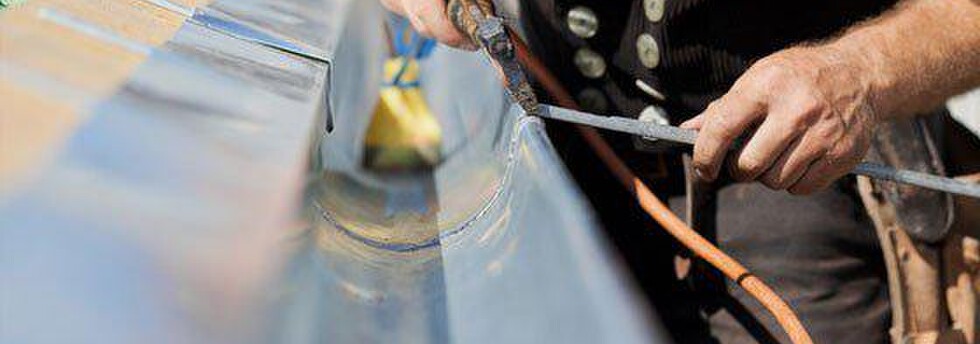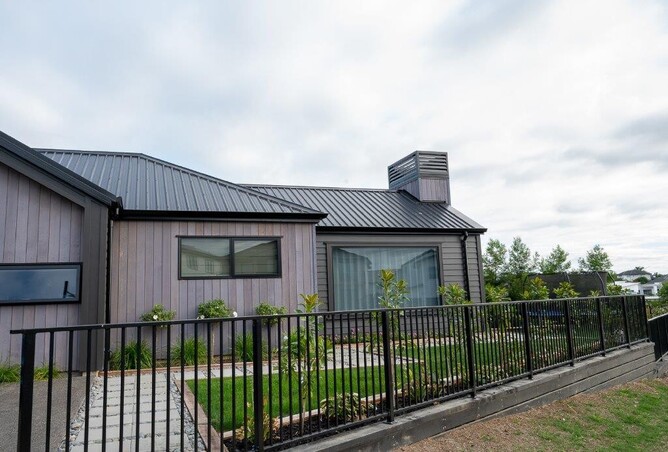Guttering is an essential component of every home and business in Hamilton and Waikato, and yet it is often overlooked or ignored until there is a problem.
Fine Line Fascia and Spouting are experts in guttering in Hamilton and look forward to helping you in any way we can.
This guide will explain everything you need to know about guttering, from its purpose and function to the different types available and how to maintain it.
What is guttering?
Guttering is a system of channels and pipes that collect and carry away rainwater from the roof of a building.
Guttering is installed around the perimeter of the building and is typically connected to downpipes which convey the water away from the building.
Guttering is usually attached to the roofline using brackets, which are screwed or bolted into the fascia board. The guttering is then hung from the brackets and held in place by clips or hangers.
The downpipes are the pipes that carry the rainwater from the guttering to the ground, and are usually made from the same material as the guttering.
Downpipes are available in a variety of different diameters to suit different guttering systems, and are usually connected to the guttering using a bracket or Union.
One of Hamilton's greatest features is our beautiful trees. But where there are trees there are leaves falling into gutters. Gutter guards are installed over the top of the guttering to keep leaves and debris out, and to prevent blockages. Gutter guards are available in a variety of different materials, including plastic, metal and mesh.
Why is guttering important?
Guttering protects the structure of a building by channeling water away from its foundation and preventing it from seeping into the walls or basement. Without guttering, water would pool around the base of the building, causing serious damage over time.
Gutters also prevent mold and mildew from forming by redirecting water away from areas where these fungi thrive. With Hamilton's spectacular fog, it is essential to ensure your building is protected.
Water can cause a great deal of damage to a home’s foundation, so it is important to make sure that gutters are installed properly and that they are regularly maintained.
What are the different types of guttering?
Sectional and seamless
Sectional guttering is made up of pre-formed sections that are joined together on site, while seamless guttering is made from a single piece of material that is cut to fit the length of the roof.
Seamless guttering is generally considered to be more durable and effective, but it is also more expensive.
In Hamilton and throughout New Zealand, we usually refer to sectional guttering as continuous guttering.
Continuous guttering
Continuous guttering is a popular choice for many New Zealand homeowners as it offers a number of advantages over traditional guttering systems. Continuous guttering is made from a continuous piece of material, usually aluminium, that is custom-fitted to the home. This means there are no gaps or joints in the guttering, which eliminates the potential for leaks.
Continuous guttering is also less likely to become blocked as there are no joints or crevices for leaves and other debris to build up in. And, because the gutters are fitted to the contours of the roof, they are less likely to sag or pull away from the fascia over time.
Installing continuous guttering is generally more expensive than traditional guttering systems, but the long-term benefits are worth the investment.
Profiles
There are several types of guttering systems available on the market, but the most common in Hamilton is the quarter-round gutter. This type of gutter is easy to install and maintain, and is also one of the most affordable options.
The Old Gothic profile remains a popular choice for people who prefer a more traditional or classic profile. While it is often used for colonial style homes, it looks great onmodern homes as well.
Another popular type of gutter system is the square gutter, which is often used on commercial buildings. This system is more durable and can handle a greater volume of water than half-round gutters.
Guttering Materials
PVC guttering
PVC guttering is very popular type of guttering in Hamilton. It is made from durable plastic, making it resistant to corrosion and rot. PVC guttering is also relatively easy to install and is available in a range of colours, although it is most commonly white.
However, PVC guttering can become brittle over time, particularly in cold weather, and it is also susceptible to damage from UV rays.
Galvanised steel guttering
Galvanised steel guttering is less popular than PVC guttering, but is still a good option for those looking for a durable and long-lasting guttering system. Steel guttering is more expensive than PVC guttering, but is less likely to suffer from corrosion.
Copper guttering
Copper guttering is a popular choice for those looking for a high-quality guttering system. Copper is a very durable material and is resistant to corrosion. Copper guttering is also available in a range of colours. However, copper guttering is more expensive than both PVC and steel guttering.
Aluminium guttering
Aluminium guttering is a good choice for those looking for a lightweight guttering system. Aluminium is also resistant to corrosion and is available in a range of colours.
Colorcotemake excellent aluminium guttering that is well protected for Hamilton's conditions.
Coated steel guttering
Similar to aluminium, coated steel guttering is resistant to corrosion and is available in a range of colours.
New Zealand's Colorsteelis preferred guttering for many Hamilton homes, and is well protected for Hamilton's conditions.
Stainless steel guttering
Stainless steel guttering is the most expensive type of guttering, but is also the most durable. Stainless steel guttering is resistant to corrosion and is available in a range of colours.
Colorcote • Colorsteel • Galvanised • Zincalume • ZAM • Copper • Aluminium • Stainless steel
How do I choose the right guttering for Hamilton buildings?
When choosing the right type of guttering for your home or office, you need to consider a number of factors.
Consider the climate in which you live
Hamilton can have a lot of rainfall, and so you will need to choose a guttering system that is designed to withstand the heavy rains. If you live in an area with very little rainfall, you may be able to get away with a less durable guttering system.
Think about the type of roof you have
If you have a flat roof, you will need to choose a guttering system that is designed to drain the roof effectively. If you have a pitched roof, you may be able to get away with a less durable guttering system.
Consider is the environment you live in
If you live in a part of Hamilton with a lot of trees, you will need to choose a guttering system that is designed to withstand the weight of the leaves and branches.
If you live in an area with a lot of wind, you may be able to get away with a less durable guttering system.
Reflect the style of your home
If you have a traditional home, you'll probably want to choose a half-round or box gutter. However, if you have a contemporary home, you may want to consider a more modern gutter style.
Think about the type of guttering
There are two main types of guttering – plastic and metal. Plastic guttering is a popular choice for homes in Hamilton. It’s easy to install, lightweight and relatively cheap.
Metal guttering is more expensive but it’s also more durable and weather-resistant. If you live in an area that experiences high winds, metal guttering is a good choice as it’s less likely to blow off in a storm.
Factor in the size of the gutters
Gutters come in a range of different sizes. The size you need will depend on the size of your roof. For example, if you have a small roof, you won’t need large gutters. If you’re not sure what size gutters you need, we are happy to advise you.
Consider the profile you like
Gutters come in a variety of different styles, from traditional round gutters to modern square gutters. The style you choose will depend on your personal preference and the style of your home.
Think about the colour of the gutters
Gutters are available in a range of different colours. The most popular choice is white, but you can also find gutters in black, brown, cream and other colours.
What are the most common guttering problems we see in Hamilton?
It's inevitable that over time your home's gutters will become clogged with leaves, dirt and other debris. And when that happens, they can cause a number of problems – from water damage to your home's foundation to flooding in your basement or crawl space. That's why it's important to keep them clean and in good repair.
If your gutters are damaged, they will need to be repaired or replaced. Minor damage, such as small holes or cracks, can be repaired with sealant or patches. More significant damage, such as large holes or cracks, will require the entire section of guttering to be replaced.
So how do you know when it's time to have your gutters cleaned or repaired? Here are the signs we see all too often in Hamilton:
1. Water is spilling over the sides of your gutters
This is a sure sign that your gutters are clogged and need to be cleaned.
2. Your gutters are sagging or pulling away from your home
This is a sign that the weight of the debris in your gutters is too much for them to handle and they need to be reinforced or replaced.
3. You see cracks or holes in your gutters
This is a sign that your gutters are old and need to be replaced.
4. The fall on your spouting is insufficient or uneven
Not having the correct amount of fall in your spouting can result in water pooling along the gutter, as it is not fully draining after rain. This can usually be adjusted if the spouting is otherwise in good condition.
5. You see water stains on your foundation or in your basement
This is a sign that your gutters are not directing water away from your home and need to be repaired or replaced.
If you are unsure how to repair or replace your gutters, call Fine Line to do the work for you. In most cases, the cost of gutter repairs is far less than the cost of replacing your gutters. And in many cases, the repairs can be made quickly and easily, without having to replace your gutters.
How can I prevent problems with my guttering?
Your guttering will get blocked from time to time. Leaves, dirt and debris can all contribute to a blockage, which can cause water to overflow and damage your home.
Here are some tips to help you prevent problems with your guttering:
1. Make sure they’re installed properly
The first step to preventing problems with your gutters is to make sure they’re installed properly in the first place. This means ensuring that they’re the right size and fit for your home, and that they’re installed correctly.
If you’re not sure, it’s always best to hire professionals like Fine Line to install your gutters. We’ll be able to do it quickly and correctly, and will also be able to advise you on the best type of gutter for your home.
2. Keep your gutters clean
One of the best ways to prevent gutter problems is to keep them clean. You can do this yourself by using a ladder to reach the gutters and remove any leaves or debris.
If you don’t feel comfortable doing this, you can hire a professional gutter cleaning service.
3. Install gutter guards
Gutter guards are designed to keep leaves and other debris out of your gutters. They’re not 100% effective, but they can help reduce the amount of debris that gets into your gutters and reduce the risk of a blockage.
4. Inspect your gutters regularly
It’s a good idea to inspect your gutters at least once a year to look for any signs of damage or wear. If you spot any problems, you can repair them before they cause serious damage.
5. Get your gutters repaired or replaced
If your gutters are damaged, you may need to get them repaired or replaced. This is best done by a professional.
6. Don’t wait until there’s a problem
If you wait until there’s a problem with your gutters before you take action, it will be more difficult and expensive to fix. It’s better to take preventive measures to avoid problems in the first place.
How do I maintain my guttering?
Guttering should be inspected at least once a year to ensure that it is free of debris and functioning properly. Debris can build up in your gutters and cause them to clog, which can lead to water damage.
In Hamilton we often see guttering that is old and in need of repair. This is because our climate can be quite damp, humid and harsh, and the elements can take their toll on our guttering.
There are a few different ways that you can clean your gutters, and the best method will depend on the type of guttering you have and the access you have to them.
1. Use a ladder
If you have a ladder, you can simply climb up and remove any debris by hand. If you have gutters that are difficult to reach, you may need to use aPower Washerto remove the debris.
2. Flush with water
Once you have removed all of the debris from your gutters, you will need to flush them out with water to remove any remaining dirt or debris. You can use a garden hose for this, or you can attach a pressure washer to your hose and use that to flush out the gutters.
3. Check for leaks
After you have flushed out your gutters, you will need to check for any leaks or damage. If you find any leaks, you will need to repair them as soon as possible to prevent further damage.
If you live in an area with a lot of trees, it's important to have your gutters inspected and cleaned on a more regular basis. This is because tree leaves can quickly clog up gutters, and they can also cause damage if they fall into them.
If you do notice any clogging, or see weeds growing in your guttering, it's important to clear it as soon as possible. This can be done using a garden hose, a pressure washer, or even a plunger.
In order to protect your gutters from damage, it's a good idea to install gutter guards. These will help to keep leaves and other debris from entering your gutters, and can make cleaning them much easier.
Downpipes
Downpipes should be checked regularly for any signs of leaks, blockages, or damage, and any problems should be fixed as soon as possible. If a downpipe becomes blocked, it can cause water to build up and overflow, which can damage your home and your belongings.
In Hamilton, downpipes are particularly vulnerable to corrosion due to our damp, humid climate. If your downpipes are made of metal, it’s important to inspect them regularly for signs of rust and to repair or replace them as soon as possible if they start to show signs of wear.
Downpipes should be cleaned at least once a year, and more often if they are located in an area that is prone to leaf litter or other debris.
When cleaning your downpipes, be sure to also inspect them for any cracks, leaks, or other damage. Quality downpipes from Colorsteel will not usually rust unless they are scratched and the protective coatings are compromised.
Keep an eye out for dents or scratches when you inspect them. If you find any damage, you will need to repair or replace the affected section of pipe.
If your downpipes are made of plastic, they will not be susceptible to corrosion but they can still become blocked by debris. Regular cleaning is still essential to prevent blockages and leaks. You can clean plastic downpipes using the same methods as you would use for metal pipes.
To clean your downpipes, you’ll need a stiff brush and a hose with a high-pressure nozzle. Start by removing any debris from the top of the downpipe, and then work your way down.
If you have a lot of downpipes to clean, you may want to invest in a downpipe cleaning attachment for your pressure washer.
Call Fine Line
Your home’s gutters play an important role in protecting your home from water damage. By redirecting rainwater away from your home, gutters help to prevent leaks, flooding, and water damage to your home’s foundation.
In order to keep your gutters functioning properly, it is important to regularly clean them out and inspect them for damage. With proper care, your gutters can help keep your home safe from water damage for many years to come.
Call Fine Line for a free quote on 021 124 4972 or send us a message and we will get back to you soon.







